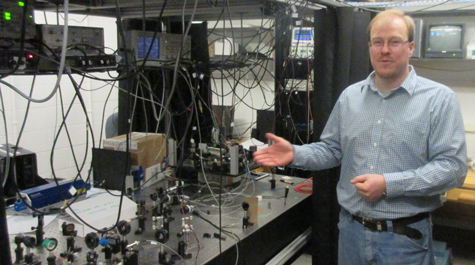Gravitational waves: Eugeniy Mikhailov helps to prove Einstein right (again)
William & Mary’s physics community squeezed into a single room the morning of Feb. 11 to hear the announcement, a group of just-from-class undergraduates finding room on the floor and in odd corners.
Rumors had been flying around the physics universe about the announcement from LIGO for weeks, but Eugeniy Mikhailov was the only one in the room who knew for sure before the announcement was made. Mikhailov, an assistant professor in William & Mary’s Department of Physics, is a member of the LIGO Scientific Collaboration (LSC), the group at the center of the announcement.
The announcement itself was simple, coming from David Reitze, executive director of the LIGO: “We have discovered gravitational waves.” The statement ended weeks of speculation among scientists and science-watchers, but more importantly confirmed a key element of Albert Einstein’s General Theory of Relativity 101 years after Einstein devised the theory.
LIGO — the Laser Interferometer Gravitational-Wave Observatory — actually is a pair of observatories, one in Louisiana, the other in Washington. Both detectors, called interferometers, were designed and built to detect incredibly tiny vibrations from passing gravitational waves. In turn, it takes huge cosmic gravitational events — neutron stars or black holes merging, a supernova — to generate gravitational waves large enough to be detected by LIGO’s interferometers.
The February announcement regarded a set of September readings by both the Louisiana and Washington observatories that registered gravitational waves that resulted from the merging of two black holes about a billion years ago. The event was so far away that the gravitational waves, traveling near the speed of light, just rippled through Earth last fall.
Both observatories recorded identical readings at the same time, as per the LIGO two-interferometer design. Speaking after the announcement webcast, Mikhailov explained that the odds of the Washington and Louisiana observatories registering false identical readings were beyond infinitesimal.
“It was a five-Sigma event,” he said, using the scientific term for proof far, far beyond a reasonable doubt.
The LIGO interferometers are subject to odd random signals. Teeny seismic events can make a big difference for instance, but even more troublesome is what scientists call quantum noise. Mikhailov says, simply, that quantum noise comes from nature. When quantum noise is detected it appears much like static on a radio that comes from the twanging of Earth’s magnetic field or sunspots.
Mikhailov’s role in the LIGO collaboration is to get a handle on the quantum noise, to find ways to suppress it or minimize it.
“It’s like waves on the ocean,” he said. “You can’t get rid of the waves, but you can find scientific ways to suppress them.”
A press release from the collaborative notes that Mikhailov joined the LSC in 2003 during his postdoctoral study at MIT, where he participated in the first demonstration of the quantum enhanced gravitational wave detector prototype and its compatibility with the main LIGO facilities.
He continued to work on ways to enhance the gravitational antenna sensitivity via suppression of the quantum noise with light-atom interactions at William & Mary. In 2012, the Mikhailov’s research group officially joined the LSC, and William & Mary became an institutional member of the collaboration. The university is the only Virginia member of the LSC.
“The direct observation of the gravitational signal is groundbreaking and, certainly, just the beginning in gravitational wave astronomy,” Mikhailov said. “LIGO detectors enable scientists to see the previously unseen. Here at William & Mary, we are developing non-conventional ways to make such observations more frequent and robust.” says Mikhailov.
The LIGO project was conceived by researchers at the Massachusetts Institute of Technology and the California Institute of Technology, and has expanded into a collaboration supported by the National Science Foundation that includes nearly a thousand scientists, including Mikhailov.
He is a co-author on a paper documenting the gravitational waves discovery published in the journal Physical Review Letters immediately following the announcement. Other William & Mary co-authors on the paper are graduate students Mi Zhang and Gleb Romanov, and an undergraduate physics major, Hunter Rew ’16.
Two other William & Mary physics majors, Eve Chase ’16 and Melissa Guidry ’17, also worked on the LIGO associated projects during the NSF-sponsored summer research activities.
The implications of the gravitational wave discovery go far beyond proving that Einstein was right about yet another aspect of the universe. Mikhailov echoed comments made during the LIGO announcement that we have entered the age of gravitational-wave astronomy. Just as Galileo’s telescopes allowed humans to perceive farther than the naked eye, and radio astronomy extended our range, Mikhailov explained, LIGO and the next generation of gravitational wave detectors can expand our horizons into the cosmos.
“It’s a new window on the world,” he said. Skip to main content
Skip to main content

